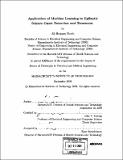Application of machine learning to epileptic seizure onset detection and treatment
Author(s)
Shoeb, Ali Hossam, 1981-
DownloadFull printable version (14.57Mb)
Other Contributors
Harvard University--MIT Division of Health Sciences and Technology.
Advisor
John V. Guttag.
Terms of use
Metadata
Show full item recordAbstract
Epilepsy is a chronic disorder of the central nervous system that predisposes individuals to experiencing recurrent seizures. It affects 3 million Americans and 50 million people world-wide. A seizure is a transient aberration in the brain's electrical activity that produces disruptive physical symptoms such as a lapse in attention and memory, a sensory hallucination, or a whole-body convulsion. Approximately 1 out of every 3 individuals with epilepsy continues to experience frequent seizures despite treatment with multiple anti-epileptic drugs. These intractable seizures pose a serious risk of injury, limit the independence and mobility of an individual, and result in both social isolation and economic hardship. This thesis presents novel technology intended to ease the burden of intractable seizures. At its heart is a method for computerized detection of seizure onset. The method uses machine learning to construct patient-specific classifiers that are capable of rapid, sensitive, and specific detection of seizure onset. The algorithm detects the onset of a seizure through analysis of the brain's electrical activity alone or in concert with other physiologic signals. When trained on 2 or more seizures and tested on 844 hours of continuous scalp EEG from 23 pediatric epilepsy patients, our algorithm detected 96% of 163 test seizures with a median detection delay of 3 seconds and a median false detection rate of 2 false detections per 24 hour period. (cont.) In this thesis we also discuss how our detector can be embedded within a low power, implantable medical device to enable the delivery of just-in-time therapy that has the potential to either eliminate or attenuate the clinical symptoms associated with seizures. Finally, we report on the in-hospital use of our detector to enable delay-sensitive therapeutic and diagnostic applications. We demonstrate the feasibility of using the algorithm to control the Vagus Nerve Stimulator (an implantable neuro stimulator for the treatment of intractable seizures), and to initiate ictal SPECT (a functional neuroimaging modality useful for localizing the cerebral site of origin of a seizure).
Description
Thesis (Ph. D.)--Harvard-MIT Division of Health Sciences and Technology, 2009. Cataloged from PDF version of thesis. Includes bibliographical references (p. 157-162).
Date issued
2009Department
Harvard University--MIT Division of Health Sciences and TechnologyPublisher
Massachusetts Institute of Technology
Keywords
Harvard University--MIT Division of Health Sciences and Technology.